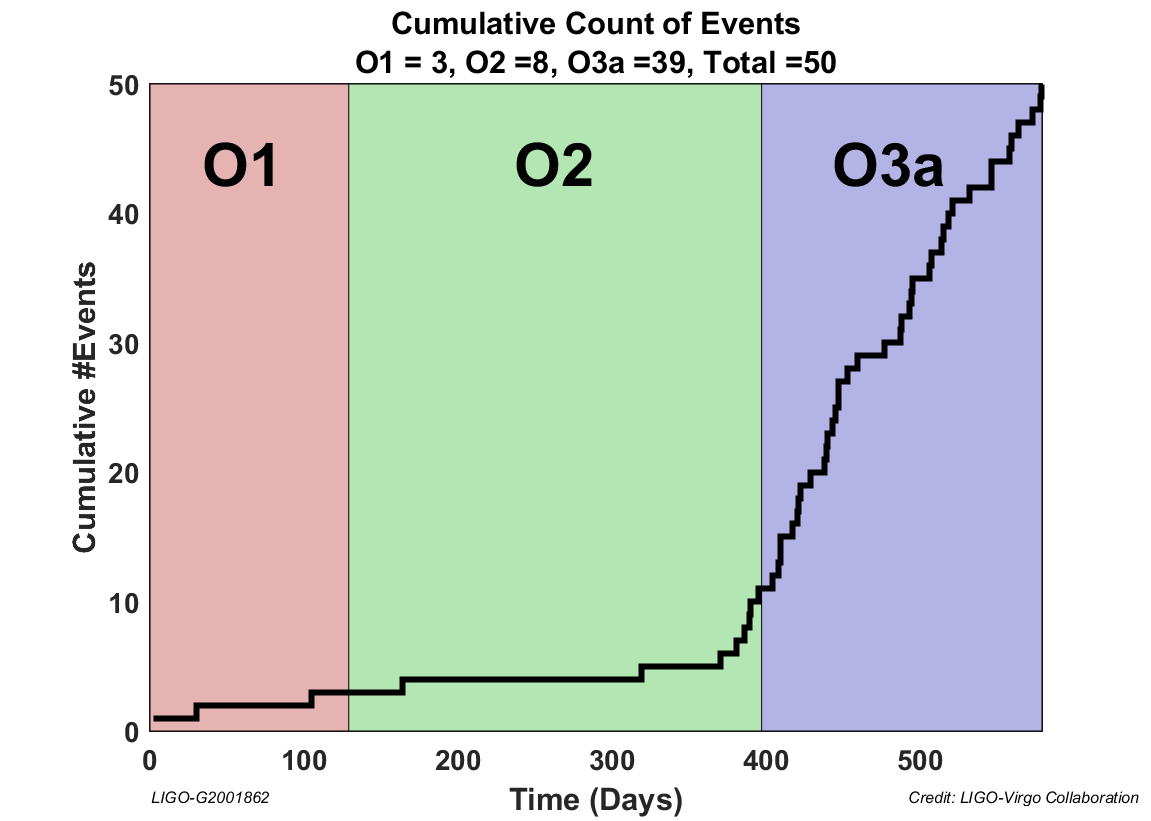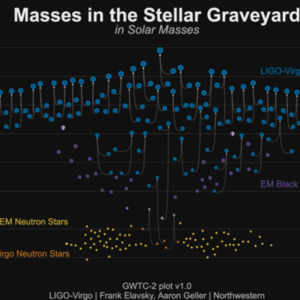
The second catalog of gravitational wave events "GWTC-2", was published today. Since September 2015, LIGO/Virgo have detected 50 gravitational waves, including 39 new ones just from the first half of O3. This graphic illustrates the current total number and masses of LIGO/Virgo black hole and neutron star merger events (in blue) compared with previously known black holes (in purple). Mergers are indicated by arrows connecting two progenitor objects with a final merged object of higher mass. Credit: LIGO-Virgo / Northwestern U / Frank Elavsky & Aaron Geller
LIGO and Virgo Announce New Detections in Updated Catalog
News Release • October 28, 2020
By Maximiliano Isi and Colm M. Talbot

Cumulative count of gravitational wave events detected by LIGO/Virgo, split by observing run. O1 yielded 3 detections, O2 yielded 8 detections, and just the first half of O3 yielded 39 detections! Collectively, the 2.5 observing runs represented here covered nearly 600 days since Sept. 2015, though some days within runs, no detectors were operating due to maintenance or environmental factors. (Click for larger image).
After several months of thorough analysis, the LIGO Scientific Collaboration and the Virgo Collaboration have released an updated catalog of gravitational wave detections, GWTC-2. The catalog contains 50 gravitational wave detections, including 39 new signals from black-hole or neutron-star collisions detected in just the first half of the LIGO/Virgo third observing run, O3a, which ran from April 1 to Oct 1, 2019. O3a's contributions to the catalog more than tripled the number of confirmed detections (the first two observing runs combined yielded 11 detections, which were included in the first catalog, GWTC-1). The new set includes some of the most interesting systems we have seen so far, and enables qualitatively new studies of astrophysical populations and fundamental physics.
The sharp increase in the number of detections was made possible by significant improvements to the instruments with respect to previous observation periods. These included increased laser power, improved mirrors and, remarkably, the use of quantum squeezing technology. All together, these enhancements resulted in a ~60% improvement in the range to which signals can be detected over the range achieved in the previous observing run, O2.
The detectors were also able to operate without interruption for longer periods of time than in the past, increasing opportunities to capture passing gravitational wave signals. We use a statistic called a "duty cycle" to describe these times. Virgo's duty cycle was 76%, meaning it was operating for 76% of the time between April 1 and October 1. LIGO Hanford and Livingston detectors achieved duty cycles of 71% and 76% respectively. All three were operating simultaneously for 44.5% of the time, while for nearly 82% of time, there were two detectors operating in unison. These are remarkable feats given the complexity of the instruments and how vulnerable they are to environmental and seismic conditions.
With all of these new signals, we can begin to better understand the populations of black holes and neutron stars that exist in the greater universe. By analyzing the entire population of binary black hole mergers simultaneously, we can maximize the astrophysical information we extract. We infer that the distribution of black hole masses does not follow a simple power-law distribution. Measuring the deviations from this power law will enable us to learn about the formation of these black holes, be they from stellar deaths or previous collisions of smaller black holes. Considering the entire population together, we can also study difficult-to-measure properties such as black hole spin. In this catalog, we find that some merging black holes have spins that are misaligned with their orbital angular momentum, raising questions about how they formed. This discovery and further observations will allow us to probe the regimes in which these binaries formed.
We can also use the many signals in the updated catalog to put Einstein’s theory of gravity (general relativity) to the test in more and better ways than before. This was done by comparing the data against predictions from the theory, and constraining possible deviations. The results from multiple signals were combined using new statistical methods to obtain the tightest constraints so far on the properties of gravity in the strong, highly-dynamical regime of black hole mergers. With the new catalog, LIGO and Virgo were also able to directly study the properties of the remnant objects produced during the mergers: by measuring the vibrations of these objects, and by ruling out potential echoes after the main signals, LIGO and Virgo confirmed that the remnants behaved as we expect from black holes in Einstein’s theory.
The 39 new detections reported in the new catalog correspond to only the first six months of LIGO and Virgo’s third observing run. Results from the remaining five months of O3 are currently being analyzed. In the meantime, the LIGO and Virgo instruments are undergoing upgrades to prepare for the fourth observing run (planned to begin in mid-2022), which will also include the KAGRA detector in Japan. More exciting discoveries are on the horizon!
Additional Reading
- A science summary of the entire GWTC-2 catalog paper can be found here: https://www.ligo.org/science/Publication-O3aCatalog/index.php
- More detail on the first LIGO/Virgo gravitational wave transient catalog (GWTC-1) can be found in these two papers: GWTC-1: A Gravitational-Wave Transient Catalog of Compact Binary Mergers Observed by LIGO and Virgo during the First and Second Observing Runs and Binary Black Hole Population Properties Inferred from the First and Second Observing Runs of Advanced LIGO and Advanced Virgo
- An animated "Orrery" comparing 38 binary black holes observed by LIGO/Virgo (animation by SXS Collaboration)
Max Isi is a NASA Einstein Post-Doctoral Fellow at MIT. He is interested in using gravitational wave signals to probe Einstein’s general relativity and learn about fundamental physics in general.
Colm Talbot is a Postdoctoral Research Fellow at Caltech studying gravitational-wave astronomy, astrophysical inference, and computational astro-statistics.




